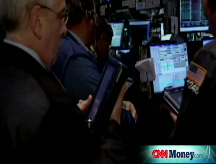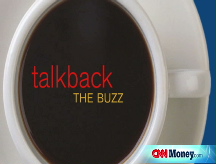Bonds rally in volatile trade
Treasurys gyrate as $75 billion of debt hit the market and investors shift away from equities.
NEW YORK (CNNMoney.com) -- Treasury prices rallied off morning lows Monday as investors digested $75 billion worth of government debt headed to market and investors shifted away from equities.
Meanwhile, bank-to-bank lending rates continued to show a credit market thaw. When lending between banks becomes cheaper, other businesses and consumers can borrow money more easily as well.
Debt prices flip-flopped in the morning session, moving from negative to positive territory after the U.S. markets opened. Treasury prices have been fluctuating in a tight range - rising demand boosts prices while the resulting influx of supply pressures prices.
"You should expect volatility - substantial volatility in this type of marketplace because the market is fragile," said Kenneth Naehu, managing director and head of fixed income at Bel Air Investment Advisors.
A barrage of negative economic news has reinforced the intensity of the recession for investors. Most recently, the government reported Friday that the U.S. economy lost 524,000 jobs in December, bringing the year's total job losses to 2.6 million. The U.S. Labor Department also reported that the unemployment rate rose to 7.2% in December.
But, with no new economic reports on Monday, investors were reacting to a selloff on Wall Street.
"The movement in equities is about the only thing we have to hang our hat on," said Mary Ann Hurley, vice president of fixed income trading at D.A. Davidson.
That may change later in the week with reports due on retail sales, inflation and industrial production.
Government rescue: As the economy spirals downward, the government continues to step in with massive rescue packages. And in order to fund those expensive programs, the government sells Treasurys.
In turn, investors purchase Treasurys when they are scared of severe losses in other parts of the marketplace because government debt is considered the safest place to keep cash.
On Monday, President-elect Barack Obama asked the Bush administration to request Congress release the remaining $350 billion of the $700 billion bailout, or Troubled Asset Relief Program.
Hurley and Naehu both said that markets had largely expected the government to go back to Congress and ask for the rest of the bailout funds. Now market watchers are looking for "any new stipulation the Congress puts on the release of that money or if they try to put stipulations on the initial TARP bailout," said Hurley.
And Obama promised quite a few on Monday. In a letter addressed to the leadership of the Senate and House of Representatives, a top Obama economic aide laid out five priorities for the use of the remaining balance under the Treasury Department's $700 billion Troubled Asset Relief Program, or TARP.
"The plan that the new administration has in place will have to be financed, so you can't talk about an increase in the deficit without assuming there will be a subsequent increase in supply in terms of Treasurys," Naehu said.
Over the next two days, the Treasury will auction $75 billion worth of debt. On Monday the Treasury auctioned $26 billion worth of 13-week bills and $27 billion worth of 26-week debt. And Tuesday, the government had $22 billion worth of 52-week bills scheduled to auction.
Treasury prices rose Friday. Bond prices have been mostly lower since the year started after sharply rallying in all of 2008.
Debt prices: The benchmark 10-year note rose 25/32 to 112-19/32 while its yield fell to 2.31% from 2.39% late Friday. Bond prices and yields move in opposite directions.
The 30-year long bond reversed course to add 1-13/32 to 129-7/32, and its yield sank to 3% from 3.06%.
In the longer-maturity bond market, demand for a safe haven was tempered by concern over inflation and the value of the dollar, according to Naehu. With the government providing seemingly limitless funding for government programs, investors fear the deterioration of the value of the greenback as the deficit expands.
The 2-year note also gained 1/32 to 100-8/32, and its yield was 0.75%.
The yield on the 3-month Treasury bill held steady at 0.07%. The short-term bill is read as a gauge of investor confidence because mutual funds and other investors shuffle funds into and out of the note as they assess risk in other parts of the marketplace. Toward the end of 2008, investors were buying 3-month Treasurys with a yield at or just above 0%, meaning they were not making any profit.
Some of the shorter-maturity notes have recently traded at historically low yields, and investors started to grow impatient with the lack of profit. According to Naehu, that fostered increased interest in other kinds of bonds - such as corporate bonds and municipal bonds - that are still safe, but offer a slightly higher level of return.
Lending rates: Government programs initiated by central banks around the globe have helped to stabilize the credit markets, following a record surge in lending rates after the September collapse of Lehman Brothers.
The Bank of England lowered its key lending rate last week to a historic low of 1.5% from 2%, and the European Central Bank is due to announce its next monetary policy decision later this week.
The 3-month Libor fell to 1.16% from 1.26% Friday, according to data available from Bloomberg.com. The last time the 3-month lending rate fell to such levels was in April 2004. Meanwhile, the overnight Libor rate held steady at its record low of 0.10%.
Libor - the London Interbank Offered Rate - is a daily average of rates 16 different banks charge each other to lend money in London, and it is used to calculate adjustable-rate mortgages. More than $350 million in assets are tied to Libor.
Two credit market gauges also showed that confidence was returning to the market.
The "TED spread" narrowed to 1.09 percentage points from 1.19 percentage points late Friday. The higher the spread, the less willing investors are to take risks. The rate widened to historic levels as as the credit market froze in the fall. As central banks around the world have eased lending rates and worked to increase liquidity in the marketplace, the spread has come back down.
Another indicator, the Libor-OIS narrowed to 0.99 percentage points from 1.08 percentage points late Friday. The Libor-OIS spread is a measure of how much cash is available for lending between banks. It's used for determining lending rates. The bigger the spread, the less cash is available for lending. ![]()





